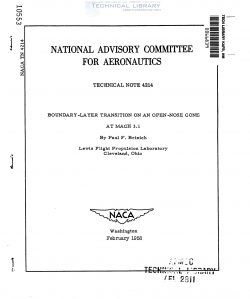naca-tn-4214
- Version
- 63 Downloads
- 482.14 KB File Size
- 1 File Count
- February 3, 2017 Create Date
- February 3, 2017 Last Updated
National Advisory Committee for Aeronautics, Technical Notes - Boundary Layer Transition on an Open-Nose Cone at Mach 3.1

The turbine stator vanes of a turboJet engine are subjected to cyclic
thermal stresses as a result of cyclic temperature distributions through-
out the vane occurring in both transient and steady-state conditions of
occur at start, during acceleration and deceleration, and when the engine
is stopped. During steady-state operation of the engine, temperature
variations also occur in the vane as a function of combustion-gas tem—
perature distribution, heat conduction and radiation paths, and cooling
air forced through the hollow vanes.
As a first approach to a determination of the magnitude of the
stresses resulting from the temperature variations, a research program
was undertaken at the Lewis Flight Propulsion Laboratory to investigate
the steady-state condition. To facilitate the measurements of the thermal
stresses, the temperature variations as measured in the engine under
steady-state conditions were duplicated in a sample vane in a bench test
setup. In addition, since the stress distribution is not affected by a
change in the average temperature, the test conditions were imposed at a
decreased average temperature, thereby making it possible to use static
high-temperature resistance-wire strain gages developed during the
investigation.
The measurement of static strains at elevated temperatures (tempera-
tures above 200° F) has posed a very serious problem in many fields of
research. Where the gage length can be made relatively long (1 in. or
more), it has been possible to obtain strain information with techniques
involving optical methods or prbbes attached at the gage points, leading
to some type of measuring device at room temperature. The strain values
obtained are, therefore, the average strain over a considerable length
and involve, in general, rather cumbersome equipment, limiting severely
the number of locations at which measurements can be made.
In reference 1 during a research program involving the development
of a high-temperature strain gage for dynamic use, Karma displayed a
low-temperature coefficient of resistance over a range of temperatures
up to 8000 or 900° F. This physical characteristic has been utilized
in a study at the Lewis laboratory to employ the Karma wire as the sensing
element of a high-temperature static strain gage.
| File | Action |
|---|---|
| naca-tn-4214 Boundary Layer Transition on an Open-Nose Cone at Mach 3.1.pdf | Download |
Comment On This Post